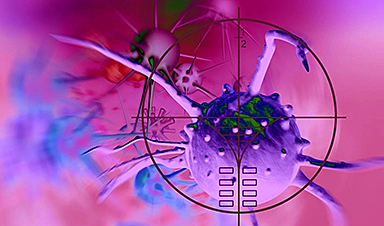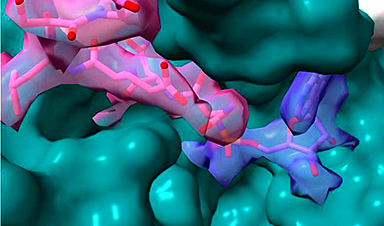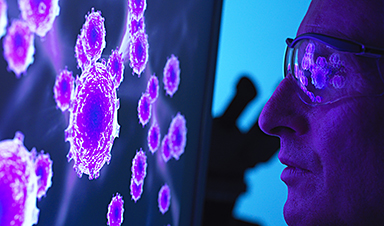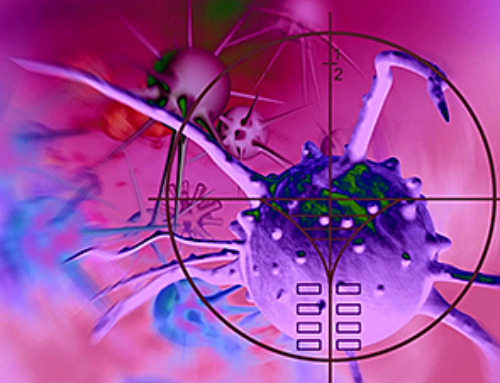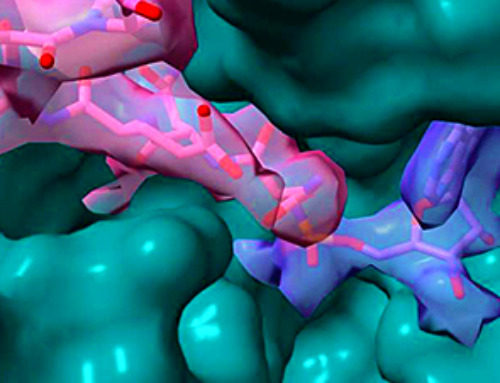Phase transition in early universe changes strength of interaction between dark and normal matter.
Dark matter remains one of the greatest mysteries of modern physics. It is clear that it must exist, because without dark matter, for example, the motion of galaxies cannot be explained. But it has never been possible to detect dark matter in an experiment.
Currently, there are many proposals for new experiments: They aim to detect dark matter directly via its scattering from the constituents of the atomic nuclei of a detection medium, i.e., protons and neutrons.
In the HYPER model, sometime after the formation of dark matter in the early universe, the strength of its interaction with normal matter increases abruptly—which on the one hand, makes it potentially detectable today and at the same time can explain the abundance of dark matter.
The new diversity in the dark matter sector
Since the search for heavy dark matter particles, or so-called WIMPS, has not yet led to success, the research community is looking for alternative dark matter particles, especially lighter ones. At the same time, one generically expects phase transitions in the dark sector—after all, there are several in the visible sector, the researchers say. But previous studies have tended to neglect them.
“There has not been a consistent dark matter model for the mass range that some planned experiments hope to access. “However, our HYPER model illustrates that a phase transition can actually help make the dark matter more easily detectable,” said Elor, a postdoctoral researcher in theoretical physics at JGU.
The challenge for a suitable model: If dark matter interacts too strongly with normal matter, its (precisely known) amount formed in the early universe would be too small, contradicting astrophysical observations. However, if it is produced in just the right amount, the interaction would conversely be too weak to detect dark matter in present-day experiments.
“Our central idea, which underlies the HYPER model, is that the interaction changes abruptly once—so we can have the best of both worlds: the right amount of dark matter and a large interaction so we might detect it,” McGehee said.
And this is how the researchers envision it: In particle physics, an interaction is usually mediated by a specific particle, a so-called mediator—and so is the interaction of dark matter with normal matter. Both the formation of dark matter and its detection function via this mediator, with the strength of the interaction depending on its mass: The larger the mass, the weaker the interaction.
The mediator must first be heavy enough so that the correct amount of dark matter is formed and later light enough so that dark matter is detectable at all. The solution: There was a phase transition after the formation of dark matter, during which the mass of the mediator suddenly decreased.
“Thus, on the one hand, the amount of dark matter is kept constant, and on the other hand, the interaction is boosted or strengthened in such a way that dark matter should be directly detectable,” Pierce said.
New model covers almost the full parameter range of planned experiments
“The HYPER model of dark matter is able to cover almost the entire range that the new experiments make accessible,” Elor said.
Specifically, the research team first considered the maximum cross-section of the mediator-mediated interaction with the protons and neutrons of an atomic nucleus to be consistent with astrological observations and certain particle-physics decays. The next step was to consider whether there was a model for dark matter that exhibited this interaction.
“And here we came up with the idea of the phase transition,” McGehee said. “We then calculated the amount of dark matter that exists in the universe and then simulated the phase transition using our calculations.”
There are a great many constraints to consider, such as a constant amount of dark matter.
“Here, we have to systematically consider and include very many scenarios, for example, asking the question whether it is really certain that our mediator does not suddenly lead to the formation of new dark matter, which of course must not be,” Elor said. “But in the end, we were convinced that our HYPER model works.”
The research is published in the journal Physical Review Letters.
News
Nano-Enhanced Hydrogel Strategies for Cartilage Repair
A recent article in Engineering describes the development of a protein-based nanocomposite hydrogel designed to deliver two therapeutic agents—dexamethasone (Dex) and kartogenin (KGN)—to support cartilage repair. The hydrogel is engineered to modulate immune responses and promote [...]
New Cancer Drug Blocks Tumors Without Debilitating Side Effects
A new drug targets RAS-PI3Kα pathways without harmful side effects. It was developed using high-performance computing and AI. A new cancer drug candidate, developed through a collaboration between Lawrence Livermore National Laboratory (LLNL), BridgeBio Oncology [...]
Scientists Are Pretty Close to Replicating the First Thing That Ever Lived
For 400 million years, a leading hypothesis claims, Earth was an “RNA World,” meaning that life must’ve first replicated from RNA before the arrival of proteins and DNA. Unfortunately, scientists have failed to find [...]
Why ‘Peniaphobia’ Is Exploding Among Young People (And Why We Should Be Concerned)
An insidious illness is taking hold among a growing proportion of young people. Little known to the general public, peniaphobia—the fear of becoming poor—is gaining ground among teens and young adults. Discover the causes [...]
Team finds flawed data in recent study relevant to coronavirus antiviral development
The COVID pandemic illustrated how urgently we need antiviral medications capable of treating coronavirus infections. To aid this effort, researchers quickly homed in on part of SARS-CoV-2's molecular structure known as the NiRAN domain—an [...]
Drug-Coated Neural Implants Reduce Immune Rejection
Summary: A new study shows that coating neural prosthetic implants with the anti-inflammatory drug dexamethasone helps reduce the body’s immune response and scar tissue formation. This strategy enhances the long-term performance and stability of electrodes [...]
Scientists discover cancer-fighting bacteria that ‘soak up’ forever chemicals in the body
A family of healthy bacteria may help 'soak up' toxic forever chemicals in the body, warding off their cancerous effects. Forever chemicals, also known as PFAS (per- and polyfluoroalkyl substances), are toxic chemicals that [...]
Johns Hopkins Researchers Uncover a New Way To Kill Cancer Cells
A new study reveals that blocking ribosomal RNA production rewires cancer cell behavior and could help treat genetically unstable tumors. Researchers at the Johns Hopkins Kimmel Cancer Center and the Department of Radiation Oncology and Molecular [...]
AI matches doctors in mapping lung tumors for radiation therapy
In radiation therapy, precision can save lives. Oncologists must carefully map the size and location of a tumor before delivering high-dose radiation to destroy cancer cells while sparing healthy tissue. But this process, called [...]
Scientists Finally “See” Key Protein That Controls Inflammation
Researchers used advanced microscopy to uncover important protein structures. For the first time, two important protein structures in the human body are being visualized, thanks in part to cutting-edge technology at the University of [...]
AI tool detects 9 types of dementia from a single brain scan
Mayo Clinic researchers have developed a new artificial intelligence (AI) tool that helps clinicians identify brain activity patterns linked to nine types of dementia, including Alzheimer's disease, using a single, widely available scan—a transformative [...]
Is plastic packaging putting more than just food on your plate?
New research reveals that common food packaging and utensils can shed microscopic plastics into our food, prompting urgent calls for stricter testing and updated regulations to protect public health. Beyond microplastics: The analysis intentionally [...]
Aging Spreads Through the Bloodstream
Summary: New research reveals that aging isn’t just a local cellular process—it can spread throughout the body via the bloodstream. A redox-sensitive protein called ReHMGB1, secreted by senescent cells, was found to trigger aging features [...]
AI and nanomedicine find rare biomarkers for prostrate cancer and atherosclerosis
Imagine a stadium packed with 75,000 fans, all wearing green and white jerseys—except one person in a solid green shirt. Finding that person would be tough. That's how hard it is for scientists to [...]
Are Pesticides Breeding the Next Pandemic? Experts Warn of Fungal Superbugs
Fungicides used in agriculture have been linked to an increase in resistance to antifungal drugs in both humans and animals. Fungal infections are on the rise, and two UC Davis infectious disease experts, Dr. George Thompson [...]
Scientists Crack the 500-Million-Year-Old Code That Controls Your Immune System
A collaborative team from Penn Medicine and Penn Engineering has uncovered the mathematical principles behind a 500-million-year-old protein network that determines whether foreign materials are recognized as friend or foe. How does your body [...]


